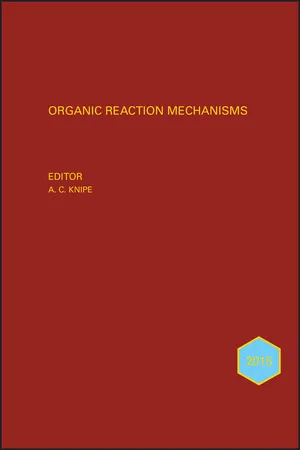
eBook - ePub
Organic Reaction Mechanisms 2013
An annual survey covering the literature dated January to December 2013
This is a test
- English
- ePUB (mobile friendly)
- Available on iOS & Android
eBook - ePub
Organic Reaction Mechanisms 2013
An annual survey covering the literature dated January to December 2013
Book details
Book preview
Table of contents
Citations
About This Book
Organic Reaction Mechanisms 2013, the 49th annual volume in this highly successful and unique series, surveys research on organic reaction mechanisms described in the available literature dated 2013.
The following classes of organic reaction mechanisms are comprehensively reviewed:
- Reaction of Aldehydes and Ketones and their Derivatives
- Reactions of Carboxylic, Phosphoric, and Sulfonic Acids and their Derivatives
- Oxidation and Reduction
- Carbenes and Nitrenes
- Nucleophilic Aromatic Substitution
- Electrophilic Aromatic Substitution
- Carbocations
- Nucleophilic Aliphatic Substitution
- Carbanions and Electrophilic Aliphatic Substitution
- Elimination Reactions
- Polar Addition Reactions
- Cycloaddition Reactions
- Molecular Rearrangements
An experienced team of authors compile these reviews every year, so that the reader can rely on a continuing quality of selection and presentation.
Frequently asked questions
At the moment all of our mobile-responsive ePub books are available to download via the app. Most of our PDFs are also available to download and we're working on making the final remaining ones downloadable now. Learn more here.
Both plans give you full access to the library and all of Perlego’s features. The only differences are the price and subscription period: With the annual plan you’ll save around 30% compared to 12 months on the monthly plan.
We are an online textbook subscription service, where you can get access to an entire online library for less than the price of a single book per month. With over 1 million books across 1000+ topics, we’ve got you covered! Learn more here.
Look out for the read-aloud symbol on your next book to see if you can listen to it. The read-aloud tool reads text aloud for you, highlighting the text as it is being read. You can pause it, speed it up and slow it down. Learn more here.
Yes, you can access Organic Reaction Mechanisms 2013 by A. C. Knipe, A. C. Knipe in PDF and/or ePUB format, as well as other popular books in Sciences physiques & Chimie organique. We have over one million books available in our catalogue for you to explore.
Information
Chapter 1
Reactions of Aldehydes and Ketones and Their Derivatives
B. A. Murray
Department of Science, Institute of Technology, Tallaght (ITT Dublin), Dublin, Ireland
- Formation and Reactions of Acetals and Related Species
- Reactions of Glucosides
- Reactions of Ketenes
- Formation and Reactions of Nitrogen Derivatives
- Imines: Synthesis, and General and Iminium Chemistry
- Mannich, Mannich-type and Nitro-Mannich Reactions
- Other ‘Name’ Reactions of Imines
- Synthesis of Azacyclopropanes from Imines
- Alkylations and Additions of Other C-Nucleophiles to Imines
- Arylations, Alkenylations and Allylations of Imines
- Miscellaneous Additions to Imines
- Reduction of Imines
- Other Reactions of Imines
- Oximes, Hydrazones and Related Species
- C–C Bond Formation and Fission: Aldol and Related Reactions
- Reviews of Aldols and General Reviews of Asymmetric Catalysis
- Asymmetric Aldols Catalysed by Proline and Its Derivatives
- Asymmetric Aldols Catalysed by Other Organocatalysts
- The Mukaiyama Aldol
- Other Asymmetric Aldols
- The Henry (Nitroaldol) Reaction
- The Baylis–Hillman Reaction and Its Morita-variant
- Other Aldol and Aldol-type Reactions
- Allylation and Related Reactions
- The Horner–Wadsworth–Emmons Reaction and Related Olefinations
- Alkynylations
- Stetter Reaction, Benzoin Condensation and Pinacol Coupling
- Michael Additions
- Miscellaneous Condensations
- Other Addition Reactions
- Addition of Organozincs
- Arylations
- Addition of Other Organometallics
- The Wittig Reaction
- Hydrocyanation, Cyanosilylation and Related Additions
- α-Aminations and Related Reactions
- Miscellaneous Additions
- Enolization, Reactions of Enolates and Related Reactions
- α-Halogenation, α-Alkylation and Other α-Substitutions
- Oxidation and Reduction of Carbonyl Compounds
- Oxidation of Aldehydes to Acids
- Oxidation of Aldehydes to Amides, Esters and Related Functional Groups
- Baeyer–Villiger and Other Oxidation Reactions of Ketones
- Miscellaneous Oxidative Processes
- Reduction Reactions
- Stereoselective Reduction Reactions
- Other Reactions
- References
Formation and Reactions of Acetals and Related Species
Equilibria for the formation of hemiacetals from eight isomeric hexanals have been measured in methanol, and compared with the steric environment around the aldehyde.1 Kinetic studies have also been carried out, and these suggest an early TS.



Table of contents
- Cover
- Title Page
- Copyright
- Table of Contents
- Contributors
- Preface
- Chapter 1: Reactions of Aldehydes and Ketones and Their Derivatives
- Chapter 2: Reactions of Carboxylic, Phosphoric, and Sulfonic Acids and Their Derivatives
- Chapter 3: Oxidation and Reduction
- Chapter 4: Carbenes and Nitrenes
- Chapter 5: Aromatic Substitution
- Chapter 6: Carbocations
- Chapter 7: Nucleophilic Aliphatic Substitution
- Chapter 8: Carbanions and Electrophilic Aliphatic Substitution
- Chapter 9: Elimination Reactions
- Chapter 10: Addition Reactions: Polar Addition
- Chapter 11: Addition Reactions: Cycloaddition
- Chapter 12: Molecular Rearrangements
- Author Index
- Subject Index
- End User License Agreement